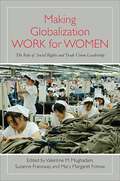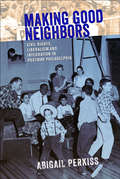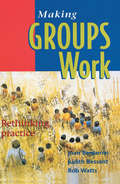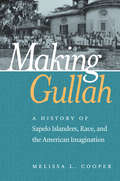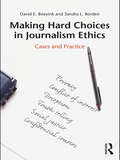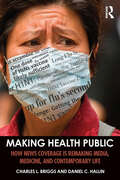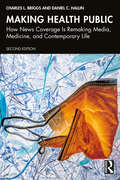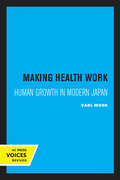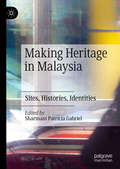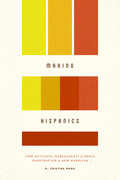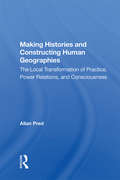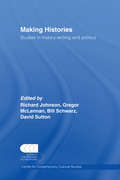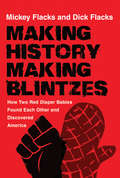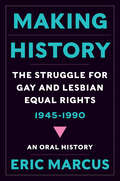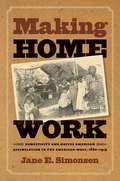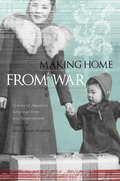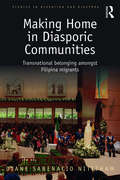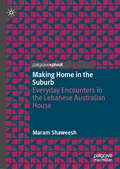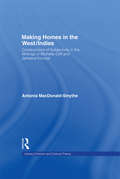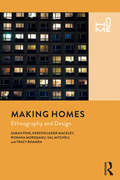- Table View
- List View
Making Global MBAs: The Culture of Business and the Business of Culture (California Series in Public Anthropology #47)
by Andrew OrtaA generation of aspiring business managers has been taught to see a world of difference as a world of opportunity. In Making Global MBAs, Andrew Orta examines the culture of contemporary business education, and the ways MBA programs participate in the production of global capitalism through the education of the business subjects who will be managing it. Based on extensive field research in several leading US business schools, this groundbreaking ethnography exposes what the culture of MBA training says about contemporary understandings of capitalism in the context of globalization. Orta details the rituals of MBA life and the ways MBA curricula cultivate both habits of fast-paced technical competence and “softer” qualities and talents thought to be essential to unlocking the value of international cultural difference while managing its risks. Making Global MBAs provides an essential critique of neoliberal thinking for students and professionals in a wide variety of fields.
Making Globalization Work for Women: The Role of Social Rights and Trade Union Leadership (SUNY series, Praxis: Theory in Action)
by Suzanne Franzway Mary Margaret Fonow Valentine M. MoghadamMaking Globalization Work for Women explores the potential for trade unions to defend the socioeconomic rights of women in a global context. Looking at labor policies and interviews with people in unions and nongovernmental organizations, the essays diagnose the problems faced by women workers across the world and assess the progress that unions in various countries have made in responding to those problems. Some concerns addressed include the masculine culture of many unions and the challenges of female leadership within them, laissez-faire governance, and the limited success of organizations working on these issues globally. Making Globalization Work for Women brings together in a synthetic and fruitful conversation the work and ideas of feminists, unions, NGOs, and other human rights workers.
Making Good Neighbors: Civil Rights, Liberalism, and Integration in Postwar Philadelphia
by Abigail PerkissIn the 1950s and 1960s, as the white residents, real estate agents, and municipal officials of many American cities fought keep African Americans out of traditionally white neighborhoods, Philadelphia’s West Mount Airy became one of the first neighborhoods in the nation where residents came together around a community-wide mission toward intentional integration. As West Mount Airy experienced transition, homeowners fought economic and legal policies that encouraged white flight and threatened the quality of local schools, seeking to find an alternative to racial separation without knowing what they would create in its place. In Making Good Neighbors, Abigail Perkiss tells the remarkable story of West Mount Airy, drawing on archival research and her oral history interviews with residents to trace their efforts, which began in the years following World War II and continued through the turn of the twenty-first century.The organizing principles of neighborhood groups like the West Mount Airy Neighbors Association (WMAN) were fundamentally liberal and emphasized democracy, equality, and justice; the social, cultural, and economic values of these groups were also decidedly grounded in middle-class ideals and white-collar professionalism. As Perkiss shows, this liberal, middle-class framework would ultimately become contested by more militant black activists and from within WMAN itself, as community leaders worked to adapt and respond to the changing racial landscape of the 1960s and 1970s. The West Mount Airy case stands apart from other experiments in integration because of the intentional, organized, and long-term commitment on the part of WMAN to biracial integration and, in time, multiracial and multiethnic diversity. The efforts of residents in the 1950s and 1960s helped to define the neighborhood as it exists today.
Making Groups Work: Rethinking practice
by Rob Watts Judith Bessant Joan BenjaminMost of us work in them, most of us live in them. Some are complex, some are simple. Some meet only once while others last for decades. Whatever form they take, groups are central to our lives. Making Groups Work offers a comprehensive introduction to the key issues in group work. It outlines the role of groups and the history of group work, discusses group politics, and shows how groups can help promote social change. Detailed case studies are used to make the crucial link between theory and practice. The authors also offer strategies for making groups work effectively. Making Groups Work is essential reading for social workers, health workers, counsellors, community workers, youth workers, trainers and anyone else interested in working with groups. It is also a good introductory text for students and a handy reference for professionals.
Making Gullah: A History of Sapelo Islanders, Race, and the American Imagination (The John Hope Franklin Series in African American History and Culture)
by Melissa L. CooperDuring the 1920s and 1930s, anthropologists and folklorists became obsessed with uncovering connections between African Americans and their African roots. At the same time, popular print media and artistic productions tapped the new appeal of black folk life, highlighting African-styled voodoo as an essential element of black folk culture. A number of researchers converged on one site in particular, Sapelo Island, Georgia, to seek support for their theories about "African survivals," bringing with them a curious mix of both influences. The legacy of that body of research is the area's contemporary identification as a Gullah community. This wide-ranging history upends a long tradition of scrutinizing the Low Country blacks of Sapelo Island by refocusing the observational lens on those who studied them. Cooper uses a wide variety of sources to unmask the connections between the rise of the social sciences, the voodoo craze during the interwar years, the black studies movement, and black land loss and land struggles in coastal black communities in the Low Country. What emerges is a fascinating examination of Gullah people's heritage, and how it was reimagined and transformed to serve vastly divergent ends over the decades.
Making Hard Choices in Journalism Ethics: Cases and Practice
by David E. Boeyink Sandra L. BordenThis book teaches students how to make the difficult ethical decisions that journalists routinely face. By taking a case-based approach, the authors argue that the best way to make an ethical decision is to look closely at a particular situation, rather than looking first to an abstract set of ethical theories or principles. This book goes beyond the traditional approaches of many other journalism textbooks by using cases as the starting point for building ethical practices. Casuistry, the technical name of such a method, develops provisional guidelines from the bottom up by reasoning analogically from an "easy" ethical case (the "paradigm") to "harder" ethical cases. Thoroughly grounded in actual experience, this method admits more nuanced judgments than most theoretical approaches.
Making Hate a Crime: From Social Movement to Law Enforcement
by Valerie Jenness Ryken GrattetIn Making Hate a Crime Valerie Jenness and Ryken Grattet show how the concept of hate crime emerged and evolved over time, as it traversed the arenas of American politics, legislatures, courts, and law enforcement. In the process, violence against people of color, immigrants, Jews, gays and lesbians, women, and persons with disabilities has come to be understood as hate crime, while violence against other vulnerable victims-octogenarians, union members, the elderly, and police officers, for example-has not.
Making Hay
by Verlyn KlinkenborgMaking Hay gives us an unforgettable glimpse of everyday life on the family farms of northwestern Iowa, southwestern Minnesota, and Montana's Big Hole Valley. Klinkenborg evokes a way of life at risk, and weaves an unforgettable story of the richness of rural living.
Making Health Public: How News Coverage Is Remaking Media, Medicine, and Contemporary Life
by Charles L. Briggs Daniel C. HallinThis book examines the relationship between media and medicine, considering the fundamental role of news coverage in constructing wider cultural understandings of health and disease. The authors advance the notion of ‘biomediatization’ and demonstrate how health knowledge is co-produced through connections between dispersed sites and forms of expertise. The chapters offer an innovative combination of media content analysis and ethnographic data on the production and circulation of health news, drawing on work with journalists, clinicians, health officials, medical researchers, marketers, and audiences. The volume provides students and scholars with unique insight into the significance and complexity of what health news does and how it is created.
Making Health Public: How News Coverage Is Remaking Media, Medicine, and Contemporary Life
by Charles L. Briggs Daniel C. HallinThis book examines the relationship between media and medicine. Drawing on insights from anthropology, linguistics, and media studies, it considers the fundamental role of news coverage in constructing wider cultural understandings of health and disease. The authors advance the notion of ‘biomediatization’ and demonstrate how health knowledge is co-produced through connections between dispersed sites of knowledge making and through multiple forms of expertise. The chapters offer an innovative combination of media content analysis and ethnographic data on the production and circulation of health news, drawing on work with journalists, clinicians, health officials, medical researchers, marketers, and audiences. New to this edition are new case studies, in particular about the COVID-19 pandemic. The first case study looks at pharmaceutical and biotech news, and how journalists portray the flow of information across the boundaries between science and business. The next two case studies examine pandemic news, beginning with the 2009 H1N1 “swine flu” pandemic and continuing to the COVID-19 pandemic. The final case study examines the treatment of race and racism in health news, looking at the ways it interacts with cultural constructions of health citizenship, and the forces that have produced a shift from deracialization of health news to a much stronger focus on race and racism in contemporary health news. This book is ideal for undergraduate students and scholars across the social sciences, health sciences, cultural studies, and journalism.
Making Health Work: Human Growth in Modern Japan (Studies in Demography #8)
by Carl MoskMosk shows how population quality provides a key to understanding economic growth and social change in Japan. This title is part of UC Press's Voices Revived program, which commemorates University of California Press’s mission to seek out and cultivate the brightest minds and give them voice, reach, and impact. Drawing on a backlist dating to 1893, Voices Revived makes high-quality, peer-reviewed scholarship accessible once again using print-on-demand technology. This title was originally published in 1996.
Making Heritage Together: Archaeological Ethnography and Community Engagement with a Rural Community
by Evangelos Kyriakidis Aris Anagnostopoulos Eleni StefanouMaking Heritage Together presents a case study of public archaeology by focusing on the collaborative creation of knowledge about the past with a rural community in central Crete. It is based on a long-term archaeological ethnography project that engaged this village community in collectively researching, preserving and managing their cultural heritage. This volume presents the theoretical and local contexts for the project, explains the methodology and the project outcomes, and reviews in detail some of the public archaeology actions with the community as examples of collaborative, research-based heritage management. What the authors emphasize in this book is the value of local context in designing and implementing public archaeology projects, and the necessity of establishing methods to understand, collaborate and interact with culturally specific groups and publics. They argue for the implementation of archaeological ethnographic research as a method of creating instances and spaces for collaborative knowledge production. The volume contributes to a greater understanding of how rural communities can be successfully engaged in the management of their own heritage. It will be relevant to archaeologists and other heritage professionals who aim to maximise the inclusivity and impact of small projects with minimal resources and achieve sustainable processes of collaboration with local stakeholders.
Making Heritage in Malaysia: Sites, Histories, Identities
by Sharmani Patricia GabrielThis book offers a scholarly perspective on heritage as a discourse, concept and lived experience in Malaysia. It argues that heritage is not a received narrative but a construct in the making. Starting with alternative ways of “museumising” heritage, the book then addresses a broad range of issues involving multicultural and folklore heritage, the small town, nostalgia and the environment, and transnationalism and cosmopolitanism. In so doing it delivers an intervention in received ways of talking about and “doing” heritage in academic as well as state and public discourse in Malaysia, which are largely dominated by perspectives that do not sufficiently engage with the cultural complexities and sociopolitical implications of heritage. The book also critically explores the politics and dynamics of heritage production in Malaysia to contest “Malaysian heritage” as a stable narrative, exploring both its cogency and contingency, and builds on a deep engagement with a non-western society in the service of “provincialising” critical heritage studies, with the broader goal of contributing to Malaysian studies.
Making Hispanics: How Activists, Bureaucrats, And Media Constructed A New American
by G. Cristina MoraHow did Puerto Ricans, Mexicans, and Cubans become known as Hispanics and Latinos in the United States? How did several distinct cultures and nationalities become portrayed as one? Cristina Mora answers both these questions and details the scope of this phenomenon in Making Hispanics. She uses an organizational lens and traces how activists, bureaucrats, and media executives in the 1970s and '80s created a new identity category and by doing so, permanently changed the racial and political landscape of the nation. Some argue that these cultures are fundamentally similar and that the Spanish language is a natural basis for a unified Hispanic identity. But Mora shows very clearly that the idea of ethnic grouping was historically constructed and institutionalized in the United States. During the 1960 census, reports classified Latin American immigrants as white," grouping them with European Americans. Not only was this decision controversial, but also Latino activists claimed that this classification hindered their ability to portray their constituents as underrepresented minorities. Therefore, they called for a separate classification: Hispanic. Once these populations could be quantified, businesses saw opportunities and the media responded. Spanish-language television began to expand its reach to serve the now large, and newly unified, Hispanic community with news and entertainment programming. Through archival research, oral histories, and interviews, Mora reveals the broad, national-level process that led to the emergence of Hispanicity in America.
Making Hispanics: How Activists, Bureaucrats, and Media Constructed a New American
by G. Cristina MoraHow did Puerto Ricans, Mexicans, and Cubans become known as “Hispanics” and “Latinos” in the United States? How did several distinct cultures and nationalities become portrayed as one? Cristina Mora answers both these questions and details the scope of this phenomenon in Making Hispanics. She uses an organizational lens and traces how activists, bureaucrats, and media executives in the 1970s and '80s created a new identity category—and by doing so, permanently changed the racial and political landscape of the nation. Some argue that these cultures are fundamentally similar and that the Spanish language is a natural basis for a unified Hispanic identity. But Mora shows very clearly that the idea of ethnic grouping was historically constructed and institutionalized in the United States. During the 1960 census, reports classified Latin American immigrants as “white,” grouping them with European Americans. Not only was this decision controversial, but also Latino activists claimed that this classification hindered their ability to portray their constituents as underrepresented minorities. Therefore, they called for a separate classification: Hispanic. Once these populations could be quantified, businesses saw opportunities and the media responded. Spanish-language television began to expand its reach to serve the now large, and newly unified, Hispanic community with news and entertainment programming. Through archival research, oral histories, and interviews, Mora reveals the broad, national-level process that led to the emergence of Hispanicity in America.
Making Histories And Constructing Human Geographies: The Local Transformation Of Practice, Power Relations, And Consciousness
by Allan PredThis book is intended to acquaint American historians, anthropologists, and sociologists with a discourse that questions the prioritizing of the temporal over the spatial-the historical over the geographical. Allan Pred argues that neither the study of history nor the execution of social or cultural analysis can be divorced from human-geographical
Making Histories: Studies in history-writing and politics
by CccsFirst published in 2006. Routledge is an imprint of Taylor & Francis, an informa company.
Making History / Making Blintzes: How Two Red Diaper Babies Found Each Other and Discovered America
by Mickey Flacks Dick FlacksMaking History/Making Blintzes is a chronicle of the political and personal lives of progressive activists Richard (Dick) and Miriam (Mickey) Flacks, two of the founders of Students for a Democratic Society (SDS). As active members of the Civil Rights movement and the anti-Vietnam War movement in the 1960s, and leaders in today’s social movements, their stories are a first-hand account of progressive American activism from the 1960s to the present. Throughout this memoir, the couple demonstrates that their lifelong commitment to making history through social activism cannot be understood without returning to the deeply personal context of their family history—of growing up “Red Diaper babies” in 1950s New York City, using folk music as self-expression as adolescents in the 1960s, and of making blintzes for their own family through the 1970s and 1980s. As the children of immigrants and first generation Jews, Dick and Mickey crafted their own religious identity as secular Jews, created a critical space for American progressive activism through SDS, and ultimately, found themselves raising an “American” family.
Making History: The Struggle for Gay and Lesbian Equal Rights, 1945–1990
by Eric MarcusWhen Making History was first published in 1992, the acclaimed oral historian Studs Terkel called it, “One of the definitive works on gay life.” Novelist Armistead Maupin said that author “Eric Marcus not only writes with grace and clarity but makes it look so easy—the ultimate measure of historian and novelist alike.” Now, for the first time, the original complete edition of Making History is available in e-book. Through his engaging oral histories, Eric Marcus traces the unfolding of LGBTQ civil rights effort from a group of small, independent underground organizations and publications into a national movement, covering the years from 1945 to 1990. Here are the stories of its remarkable pioneers: a diverse group of nearly fifty Americans, who hail from all corners of the nation. From the period in history when homosexuals were routinely beaten by police to the day when gay rights leaders were first invited to the White House, Making History is the story of an against-all-odds struggle that has succeeded in bringing about changes in American society that were once unimaginable.
Making Home Work
by Jane E. SimonsenDuring the westward expansion of America, white middle-class ideals of home and domestic work were used to measure differences between white and Native American women. Yet the vision of America as "home" was more than a metaphor for women's stake in the process of conquest--it took deliberate work to create and uphold. Treating white and indigenous women's struggles as part of the same history, Jane E. Simonsen argues that as both cultural workers and domestic laborers insisted upon the value of their work to "civilization," they exposed the inequalities integral to both the nation and the household.Simonsen illuminates discussions about the value of women's work through analysis of texts and images created by writers, women's rights activists, reformers, anthropologists, photographers, field matrons, and Native American women. She argues that women such as Caroline Soule, Alice Fletcher, E. Jane Gay, Anna Dawson Wilde, and Angel DeCora called upon the rhetoric of sentimental domesticity, ethnographic science, public display, and indigenous knowledge as they sought to make the gendered and racial order of the nation visible through homes and the work performed in them. Focusing on the range of materials through which domesticity was produced in the West, Simonsen integrates new voices into the study of domesticity's imperial manifestations.
Making Home from War: Stories of Japanese American Exile and Resettlement
by Brian Komei DempsterThe sequel to the award-winning From Our Side of the Fence—personal stories of life after the WWII internment camps from twelve Japanese Americans. Many books have chronicled the experience of Japanese Americans in the early days of World War II, when over 120,000 persons of Japanese ancestry, two-thirds of whom were American citizens, were taken from their homes along the West Coast and imprisoned in concentration camps. When they were finally allowed to leave, a new challenge faced them—how do you resume a life so interrupted? Written by twelve Japanese American elders who gathered regularly at the Japanese Cultural and Community Center of Northern California, Making Home from War is a collection of stories about their exodus from concentration camps into a world that in a few short years had drastically changed. In order to survive, they found the resilience they needed in the form of community and gathered reserves of strength from family and friends. Through a spectrum of conflicting and rich emotions, Making Home from War demonstrates the depth of human resolve and faith during a time of devastating upheaval. &“I remember my release from Manzanar as scary and intense, but until now so little has been said about this aspect of the internment experience. This is an important book, its stories ground-breaking and memorable.&”—Jeanne Wakatsuki Houston, author of Farewell to Manzanar &“A deeply moving accounting of life after imprisonment, its lingering stigma, and the true meaning of freedom.&”—Dr. Satsuki Ina, producer of Children of the Camps
Making Home in Diasporic Communities: Transnational belonging amongst Filipina migrants (Studies in Migration and Diaspora)
by Diane Sabenacio NitithamMaking Home in Diasporic Communities demonstrates the global scope of the Filipino diaspora, engaging wider scholarship on globalisation and the ways in which the dynamics of nation-state institutions, labour migration and social relationships intersect for transnational communities. Based on original ethnographic work conducted in Ireland and the Philippines, the book examines how Filipina diasporans socially and symbolically create a sense of ‘home’. On one hand, Filipinas can be seen as mobile, as they have crossed geographical borders and are physically located in the destination country. Yet, on the other hand, they are constrained by immigration policies, linguistic and cultural barriers and other social and cultural institutions. Through modalities of language, rituals and religion and food, the author examines the ways in which Filipinas orient their perceptions, expectations, practices and social spaces to ‘the homeland’, thus providing insight into larger questions of inclusion and exclusion for diasporic communities. By focusing on a range of Filipina experiences, including that of nurses, international students, religious workers and personal assistants, Making Home in Diasporic Communities explores the intersectionality of gender, race, class and belonging. As such, it will appeal to scholars of sociology and anthropology as well as those with interests in gender, identity, migration, ethnic studies, and the construction of home.
Making Home in the Suburb: Everyday Encounters in the Lebanese Australian House
by Maram ShaweeshThis book investigates everyday life within Lebanese Australian homes, documenting how these homes integrate Lebanese Australian culture into suburban Australian life. It explores how the homemaking practices of Lebanese Australian families both influence and are influenced by the context of suburban housing in Australia. Drawing from in-depth interviews, household tours, photographic documentation, mental mapping, and historical imagery data collection, the book illuminates homemaking practices that have evolved from creating a "home away from home" to practices influenced by a unique Lebanese Australian lifestyle, rooted in the perception of Australia as their home.
Making Homes in the West/Indies: Constructions of Subjectivity in the Writings of Michelle Cliff and Jamaica Kincaid (Literary Criticism and Cultural Theory)
by Antonia Macdonald-SmytheThis study focuses on the ways in which two of the most prominent Caribbean women writers residing in the United States, Michelle Cliff and Jamaica Kincaid, have made themselves at home within Caribbean poetics, even as their migration to the United States affords them participation and acceptance within its literary space.
Making Homes: Ethnography and Design (Home Ser.)
by Sarah Pink Roxana Morosanu Val Mitchell Tracy Bhamra Kerstin Leder MackleyMaking Homes: Anthropology and Design is a strong addition to the emerging field of design anthropology. Based on the latest scholarship and practice in the social sciences as well as design, this interdisciplinary text introduces a new design ethnography which offers unique and original approaches to research and intervention in the home.Presenting a coherent theoretical and methodological framework for both ethnographers and designers, the authors examine ‘hot’ topics – ranging from movements and mobilities to im/material environments, to digital culture – and confront the challenges of a research and design environment which seeks to bring about the changes required for a sustainable, resilient, ‘safe’, and comfortable future.Written by leading experts in the field, the book draws on real-life examples from a wide range of international projects developed by the authors, other researchers, and designers. Illustrations throughout help to convey the methods and research visually. Readers will also have access to a related website which follows the authors’ ongoing research and includes video and written narrative examples of ethnographic research in the home.Transforming current understandings of the home, this is an essential read for students and researchers in fields such as design, anthropology, human geography, sociology, and media and communication studies.

